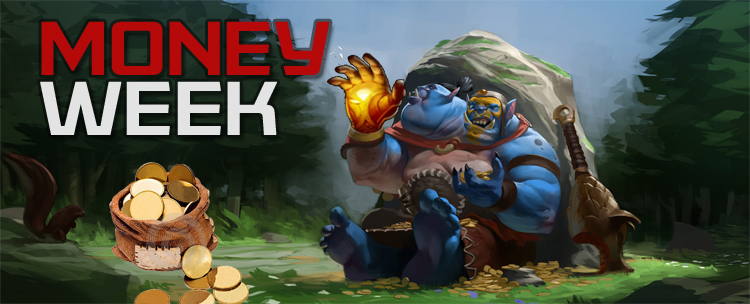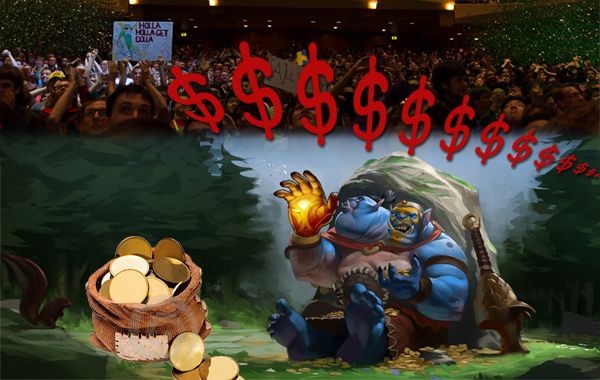
This is the third week of 2014 and the Year of the Snake is about to end and make way for the Year of the Horse. One could argue that 2013 was in fact Year of the Rat but there is no reasoning with official calendars. The Rat-year will remain as an unofficial title only, although perhaps still triggering some doubt in the minds of scholars. Anyway, only three weeks in and already have tournaments made various teams $84,000 richer. $34,000 out of those came from tournaments which both started and concluded in 2014. The remaining $50,000 can be credited to the fourth season of Dota 2 League which wrapped up one week ago whereas the date of its initiation was October 15. The grand final of WPC-ACE League is not counted in these numbers since it concluded on January 1st and it would look a bit too desperate to count that for 2014, especially regarding the time zone. For people living in the States, that particular final started in 2013 and ended in 2014. Lasting a year, quite some final, huh?
What is more interesting is this specific third week, being quite the money week on its own. Three tournaments initiated in 2013 will all conclude before it is up, although technically the StarLadder final could drag on beyond the midnight mark between Sunday and Monday and given past StarLadder events, it is more likely to happen than not. Between these three tournaments - namely Dota 2 Champions League, G-League and StarLadder - there are over $214,000 to be earned. That is in one single week. Compare to the same dates last year and that sum would not have been reached until May. What took the scene four or five months last year to amass is now done in one week.
One would have to take into account that all these tournaments have been ongoing for two to three months and having all those finals occurring within the same week is quite the fortuity for this particular article. Extreme scenario or not, the point remains that the sheer prize money for teams to win have went through a huge boom in just one year's time. With that said, it is becoming increasingly more important for the players to be at their sharpest during the particular season of multiple playoffs (November to January, June to July).
The growth of the average prize pool

In November 2011, the first season of The Defense went live and both teams and community were terribly excited, especially given the then massive prize pool of €10,000 (about $13,500 today) for a four months long tournament: It was the largest prize pool for an online tournament at the time. Having said that, there were not too many tournaments to compete with during those days and certainly even fewer large-scale tournaments. Tobiwan, the voice of Dota, further added to the hypr.
About one week ago, just tall of two years after the start of The Defense, joinDota - the tournament's host - arranged the rather casual PinnacleSports Pro-Am tournament which carried $10,000 and lasted nine days. Compare that to past years and you will spot the trend. Ten grand back in November 2011 was the biggest tournament ever and continued to be a substantial prize pool through 2012. During summer times 2013, the $10,000 prize pool indicated a mid to high tier tournament and after The International 3, you had to be able to fork out at least $25,000 for a multi-stage tournament in order to get some spotlight. Is it inflation at work? No, it is just a vast development of quality and quantity.
Dota 2 Champions League, being one of the three tournaments concluding this week, has a $50,000 prize purse attached. Dota 2 League (not to be confused with the former, one would think with all this money circulating organisers would be able to pick more creative names) also carried a sack of 50 grand, eager to throw at the winners. Can you guess the prize pool of the recent kick-off season for Dreamhack's DreamLeague? $50,000. StarLadder announced a base prize pool with the same number (getting repetitive now, huh?) plus 25% share of the DotaTV in-game ticket sales.
But all these tournaments are exceptions, right? Wrong. Dota 2 Champion's League already finished most of the qualifying games for the next upcoming season. StarLadder had four seasons in 2013 and 2014 is likely to have at least that many. With their prize pool having skyrocketed from a mere $22,500 to over $133,000 from season seven to eight, no one is expecting the dimes for season nine to regress. That €10,000 The Defense is starting to feel very distant, like ancient history.
We are all sponsors
 The big change to notice for 2014 is the rise of community funded prize pools. Following the International 3 which was the pioneer in that, both MLG and StarLadder have been able to boost their prize pools with over 160% by having the common viewer help out every time he or she buys a bundle. The bundle normally allows the viewer to access all live and played matches of the tournament within the game client, while also receiving some additional cosmetics for certain Dota 2 heroes and/or a courier. For each bundle sold, 25% goes directly to the prize pool. Dota 2 Champions League also utilizes this but since they are not set up with the sharing system used by StarLadder and MLG, there is no way to know what the number is until they reveal it themselves.
The big change to notice for 2014 is the rise of community funded prize pools. Following the International 3 which was the pioneer in that, both MLG and StarLadder have been able to boost their prize pools with over 160% by having the common viewer help out every time he or she buys a bundle. The bundle normally allows the viewer to access all live and played matches of the tournament within the game client, while also receiving some additional cosmetics for certain Dota 2 heroes and/or a courier. For each bundle sold, 25% goes directly to the prize pool. Dota 2 Champions League also utilizes this but since they are not set up with the sharing system used by StarLadder and MLG, there is no way to know what the number is until they reveal it themselves.
With this method, the end customers, or the community, are directly adding to the future sustainability of the scene. Players win more money, can commit more to the game and organisers will not have to be the ones paying.
If 25% goes for pumping the prize pool, what happens to remaining 75%, though? Valve takes a fair share (the majority) of that money and the rest goes to the tourmament organisers. This allows them to not only depend on their partners being happy and easy on the investment checks; they can now also depend on delivering a good product to the end user and having him or her buy their product. Organisers get compensated, Valve gets compensated, viewers get compensated (through the product and more prestigious tournaments) and players get compensated as long as they win. With this model we are all sponsors, or a word more frequently used in regular retail business - customers.
Most noticeable in the West
Is it every scene seeing this incredible development? Unfortunately not. It is mostly the western scene seemingly marking the end of the rainbow and the pot of gold along with it, where this type of consumerism approach is more successful and more encouraged. A system where the wealth of the market is directly stimulating the winning team's yield will benefit tournaments in the west where people are more used to buying "unnecessary" things in general. The organiser will have to ensure the satisfaction of the customer, otherwise the prize pool will drop and teams will not be as eager to participate. With top teams sitting out, the less appealing the tournament will appear for the public, and the less likely people will be to pay for the ticket. Instead they can also hook customers using custom in-game items for popular heroes as well as intriguing couriers or go back to depending on partners to a larger degree. The sales funding approach is highly competitive and depending on people willing to pay for seemingly redundant products.
Regarding increased prize pools, the Chinese scene had G-League and G-1 League (again with the creativity) in late 2012 too, which reached almost a $100,000 combined prize pool. Super League and WPC-ACE League had the largest purses outside The International in 2013 and the Alienware Cup was the biggest online tournament at the time. Clearly the Chinese scene have had these vast prize pools for some time already. The issue there, however, is that none of these tournaments can be labeled as "the average top level tournament". All of those were maximum prestige with barely anything else going on the same time and only one season a year.
Recently though, there has been more overlapping tournaments in the Chinese scene, revealing that they have also been affected by the boom. The Korean scene appeared out of nowhere with $113,000 to hand out despite not having any players to give it to. The generous Koreans also invited Western teams and threw money at them for humiliating the local Korean talents. The American scene is more or less engulfed with the European one, despite some attempts to get something more local going (American Dota League for instance). The crippled child of the situation would be South East Asia who still has the regular tournaments only offering between $1,000 and $3,000 for the top finishing teams.
Largest prize pools in 2013?
| Prize pool | Tournament | Date, start | Date, end | Winning team | |
|---|---|---|---|---|---|
| $~2,874,000 | The International 3 | August 2 | August 11 |  Alliance Alliance | |
| $~229,000 | WPC-ACE League | September 22 | January 1 (2014) |  Team DK Team DK | |
| $~163,000 | Dota 2 Super League | May 10 | July 6 |  TongFu TongFu | |
| $~137,000 | MLG Columbus | November 22 | November 24 |  Speed Gaming Speed Gaming | |
| $~133,000 | StarLadder, season 8 | November 25 | January 19 (2014) | To be decided | |
| $~113,000 | Nexon Sponsorship League, season 1 | September 28 | November 9 |  StarTale StarTale | |
Matches and stories within the money week

Which are the tournaments of the "money week" then, are there any stories to be told? The Dota 2 Champions League had a hyped match-up back in December between then still sort of reigning team Alliance and new rising team Speed Gaming. The final never happened though and was delayed until further ado and is appearing again tomorrow, rather detached from the rest of the season. The then "old school" vs "new school" is now a match between two teams which have both disappointed more than once in the recent times and will not peak as much interest. However, the timing is flawless as there are no other matches going on enthusiasts will be more or less forced to watch the match. It still has a lot of potential as it's a battle for redemption, something both teams desperately need.
Speaking of detached finals, the grand final of last season's G-League went down no less than three months after the last semi final was played. This time around, things are not as dramaticly out of place and the final will be concluded before the new year's hiatus in China. Most Chinese finals lately have featured the two teams Team DK and Invictus Gaming locking horns with each other and this final is no exception. Multiple tournaments have proven that it is, in fact, the most interesting match-up. It might also be the last (or one of the last) match-ups between the teams as defending G-League champions Invictus Gaming may see some changes. This referring of course to the fact that ChuaN might claim his revenge and steal two of the players, namely Faith and Hao.
 Then there is the StarLadder playoffs, being the stellar backbone of European Dota for quite some time now. The StarLadder model consists of an online season (multiple teams of various quality, this season featured as many as 18 teams) where four with the most points advance to the playoffs in Kiev. After using this model for, well, eight seasons, other organisers have joined the wagon. DreamLeague and Dota 2 League applied similar online into offline models. When the stellar backbone applies the partially sales-funded prize pool model and boosts the purse with over 160%, it is most likely an indicator that other upcoming tournaments need to do the same or perish to the competition. Four of the most promising teams of Europe will be attending (Natus Vincere, Alliance, Fnatic and Sigma International) and they all have the potential to win it, depending on the quality of their own performances. So the question remains, have Alliance farmed enough cash in 2013 in order to "buyback" after their D2L defeat and recover for StarLadder? Perhaps their buyback timer is still on cooldown.
Then there is the StarLadder playoffs, being the stellar backbone of European Dota for quite some time now. The StarLadder model consists of an online season (multiple teams of various quality, this season featured as many as 18 teams) where four with the most points advance to the playoffs in Kiev. After using this model for, well, eight seasons, other organisers have joined the wagon. DreamLeague and Dota 2 League applied similar online into offline models. When the stellar backbone applies the partially sales-funded prize pool model and boosts the purse with over 160%, it is most likely an indicator that other upcoming tournaments need to do the same or perish to the competition. Four of the most promising teams of Europe will be attending (Natus Vincere, Alliance, Fnatic and Sigma International) and they all have the potential to win it, depending on the quality of their own performances. So the question remains, have Alliance farmed enough cash in 2013 in order to "buyback" after their D2L defeat and recover for StarLadder? Perhaps their buyback timer is still on cooldown.
Money week schedule
Jan 15 - Dota 2 Champions League final, best-of-5, 18.00 CET
Jan 17-19 - StarLadder season eight playoffs, schedule here
Jan 19 - G-League final, best-of-5, estimated time 07.00 CET
Summary
2013 kept building up the prize pools as predicted. But what was less predicted was the impact of The International 3 and more so, the community-funded prize pool boost, raising the already impressive 1.6 million dollar prize pool almost as high as 2.9 million. Valve's approach and the attracted attention buffed up the average for a top tier tournament to more than double the amount of those prior to The International. After MLG and StarLadder picked up on the community funding and share system within the client, it is expected to see more tournaments do this throughout the year which will double the average prize pools once again. If you are good at Dota - that is really good at it - you may have quite a lot of money to earn. Where The International was the one yearly shot at fame and fortune prior to this, there will now be multiple shots. However, if more tournaments adapt the model with a massive prize pool, a qualifying season and an intense playoff period, it will boil down to which team has their peak during the playoff seasons as multiple tournaments have proven to have their playoffs at the same time.
Summary of the summary: Gold wins games and good teams are good. In 2014, winning games will give more gold and good teams will be better.

